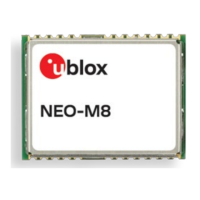NEO-8Q / NEO-M8 - Hardware integration manual
UBX-15029985 - Production information Hardware description Page 8 of 9
C1-Public
For more information about the DDC implementation, see the u-blox 8 / u-blox M8 Receiver
Description Including Protocol Specification [4]. For bandwidth information, see the corresponding
product data sheet. For timing parameters, consult the I2C-bus specification [7].
☞ The NEO-8Q and NEO-M8 series DDC interface supports serial communication with most u-blox
cellular modules. See the specification of the applicable cellular module to confirm compatibility.
1.4.4 SPI
An SPI interface is available for communication to a host CPU.
☞ SPI is not available in the default configuration, because its pins are shared with the UART and
DDC interfaces. The SPI interface can be enabled by connecting D_SEL to ground. For speed and
clock frequency, see the corresponding product data sheet.
1.4.5 TX_READY
The TX_READY function is used to indicate when the receiver has data to transmit. A listener can wait
on the TX_READY signal instead of polling the DDC or SPI interfaces. The UBX-CFG-PRT message lets
you configure the polarity and the number of bytes in the buffer before the TX READY signal goes
active. The TX_READY function can be mapped to TXD (PIO 06). The TX_READY function is disabled
by default.
☞ The TX_READY functionality can be enabled and configured by AT commands sent to the u-blox
cellular module supporting the feature. For more information, see the GPS Implementation and
Aiding Features in u-blox wireless modules [8].
1.5 I/O pins
All I/O pins make use of internal pull-ups. Thus, there is no need to connect unused pins to VCC_IO.
1.5.1 RESET_N: Reset
Driving RESET_N low activates a hardware reset of the system. Use this pin only to reset the module.
Do not use RESET_N to turn the module on and off, since the reset state increases power
consumption. With NEO-8Q and NEO-M8 series modules RESET_N is an input only.
☞ The RTC time is also reset (but not BBR).
1.5.2 EXTINT: External interrupt
EXTINT (EXTINT0 on NEO-M8T), PIO 13 is an external interrupt pin with fixed input voltage
thresholds with respect to VCC (see the corresponding product data sheet for more information). It
can be used for wake-up functions in power save mode on NEO-8Q and NEO-M8 series modules and
for aiding. Leave open if unused. The function is disabled by default.
If the EXTINT is not used for an external interrupt function, it can be used for some other purpose. For
example, as an output pin for the TX_READY feature to indicate that the receiver has data to
transmit.
EXTINT1 is an external interrupt pin on NEO-M8T with fixed input voltage thresholds with respect to
VCC (see the corresponding product data sheet for more information). It can be used for wake-up
functions in Power Save Mode on NEO-M8T module and for aiding. Leave open if unused. The function
is disabled by default.

